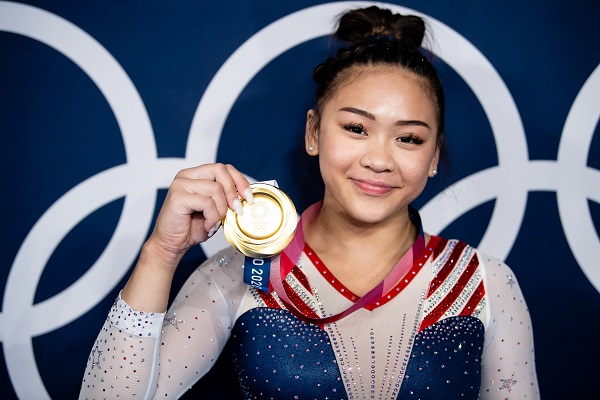While the sporting world was focusing on veteran Olympic champion Simone Biles withdrawing from the Tokyo Olympics' all-around gymnastics final because of mental health issues, an 18-year-old – the youngest member of the United States Women's Artistic Gymnastics team – quietly stepped in on the biggest stage of all to script history on Thursday.
Sunisa Lee, the first Hmong American to represent US at Olympics, grabbed the spotlight with a gold medal-winning performance at the Ariake Gymnastics Centre and become only the sixth US woman to win the all-around title at the Olympic Games.
"It feels super crazy, I definitely didn't think I would be here in this moment with a gold medal. I haven't really let it sink in yet because I feel like it's not real life," Sunisa said after her stupendous show.
The youngster has every reason to get that surreal feeling. Dramatic developments in the US gymnastics team in Tokyo over the last few days notwithstanding, Sunisa had overcome not only several injuries but also a massive personal setback en route to the gold medal.
In 2019, just two days before she was to participate in the US National Gymnastics Championships, Sunisa's father John was involved in a freak accident and left paralyzed from the waist down.
Then came the Covid pandemic last year followed by protests and mob violence triggered by the murder of George Floyd which took place not too far away from the Lees residence in Minnesota.
"It just felt like it was one thing after another. I was, like, jeez, how much can I take? It was just so stressful," Sunisa had told The Auburn Plainsman, earlier this year.
Displaying remarkable strength of character, the teenager did not lose sight of her ultimate goal – of making it to the US team for the Tokyo Olympics team.
As they say it, the rest is history.
She did it. @sunisalee_ is the queen of the women’s gymnastics all-around finals and her parents. OMG. Tears every where. 🥺 #Gold #TokyoOlympics #hmong pic.twitter.com/n2xM7VJOPq
— Gia Vang (@Gia_Vang) July 29, 2021
Already a poster girl for the Hmong community living in the US, the Olympic medal on Thursday has now made Sunisa a cult figure for the global Asian ethnic group.
According to the Hmong American Centre (HAC), having migrated from southern China in the 19th century to the mountainous areas of Laos, Vietnam and Thailand, the Hmong lived in isolation until recruited by the American intelligence agencies in the early 1960s to fight the communist regime in the region. After the US withdrew from Vietnam and Laos in 1975, thousands of Hmong sought asylum in many European and Western countries including Australia, France, Canada, Germany, and the United States.
The number of Hmong refugees grew rapidly and soon the Hmong became the third-largest Southeast Asian group in the US after Vietnamese and Cambodian, with the majority living in the states of California, Minnesota – where Sunisa was born in 2003 – and Wisconsin.
"During the early years, most refugees experienced significant challenges in adjusting to life in the United States. When accessing services in the mainstream community, language barriers and lack of familiarity with the various systems and institutions became obstacles for most. But, after several decades now, Hmong demographics have shifted to where the US born populations is larger than those born abroad," says Uee Leng Xiong, the HAC Executive Director.
As Hmong integrated into American society, slowly yet steadily, their next generation also started making waves.
Thursday was clearly a watershed moment as Sunisa stood on the podium in Tokyo.
Also Read: Volcanic islands erupt in joy after Fiji's rugby gold at Tokyo Olympics




















